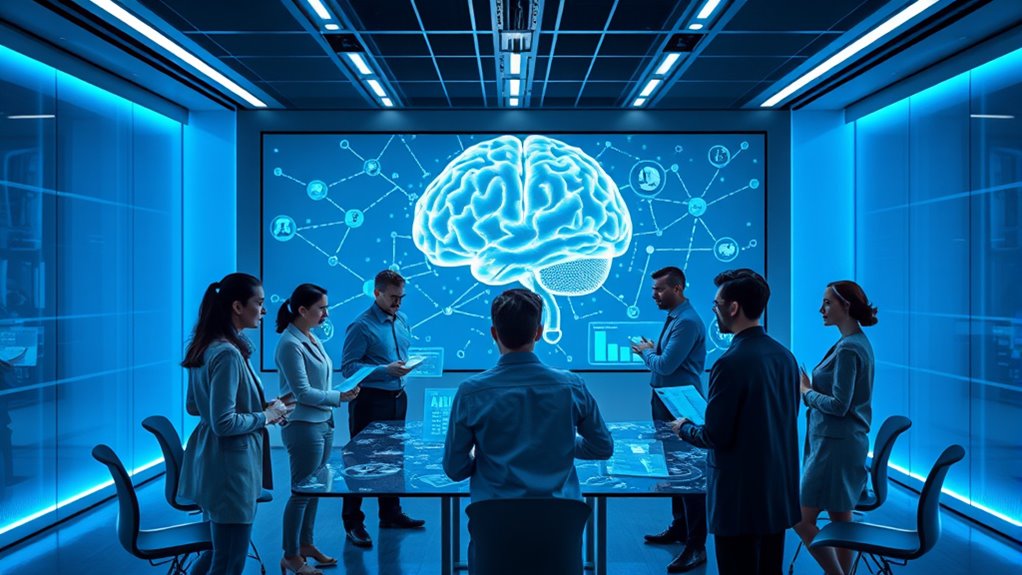AI ethics and bias in machine learning highlight how your AI systems can unintentionally reflect societal prejudices if trained on biased data. Ensuring fairness involves scrutinizing data sources, promoting transparency, and holding developers accountable. By addressing these issues, you help prevent discriminatory outcomes and build trust in AI. Understanding the moral responsibilities and challenges involved is vital for developing equitable and responsible AI solutions. Continue exploring to uncover ways to create fairer, more ethical AI technologies.
Key Takeaways
- AI ethics emphasize fairness, transparency, and accountability to prevent societal bias and ensure equitable decision-making.
- Biased training data reflects societal prejudices, leading to unfair AI outcomes that reinforce discrimination.
- Transparency in AI models fosters understanding, accountability, and trust, enabling identification and correction of biases.
- Ensuring data quality and representativeness is crucial to mitigate bias and promote ethical AI deployment.
- Developers and policymakers share moral responsibility to monitor, address, and mitigate bias throughout AI systems’ lifecycle.

Have you ever wondered how machines make decisions that can impact your life? From loan approvals to job screenings, AI systems increasingly influence critical aspects of your daily experience. At the core of these decisions lies the significance of algorithm fairness—ensuring that algorithms treat all individuals equitably and without bias. When algorithms are designed without careful attention to fairness, they can perpetuate or even amplify existing societal inequalities. This raises a fundamental question: who bears the moral responsibility for these outcomes? Developers, companies, and policymakers all share a stake in making sure AI systems are fair and ethically sound. It’s not enough for AI to be technically effective; it must also align with societal values and moral standards.
Ensuring AI fairness is a moral responsibility shared by developers, organizations, and policymakers to promote equitable technology.
Achieving algorithm fairness is complex because data used to train these models often reflect historical biases. If a dataset contains prejudiced patterns, the AI will learn to replicate those biases, leading to unfair treatment of certain groups. For example, a hiring algorithm trained on past employment data might favor one demographic over another, unintentionally reinforcing discrimination. As someone impacted by these decisions, you need to understand that fairness isn’t just a technical challenge but a moral imperative. Developers are responsible for scrutinizing data sources, implementing fairness-aware algorithms, and continuously monitoring systems for bias. They must ask themselves: Are we minimizing harm? Are we treating everyone equally? These questions underscore the moral responsibility involved in deploying AI systems.
Moreover, transparency plays a crucial role in addressing bias and fairness. When algorithms operate as black boxes, you can’t see how decisions are made, making it difficult to identify or challenge unfair outcomes. Ensuring transparency allows for accountability, giving you confidence that decisions are fair and just. This is where ethical considerations become intertwined with technical solutions. Developers and organizations need to communicate openly about how AI models are trained, what data they use, and how they address bias. Holding those responsible accountable is essential because it reinforces the moral duty to prevent harm and promote fairness. Recognizing that datasets used in AI training often mirror societal biases emphasizes the importance of training data quality and its influence on fairness and accuracy.
In the end, AI ethics isn’t just about avoiding legal trouble or public backlash; it’s about recognizing that these systems impact real lives. When you understand the importance of algorithm fairness and moral responsibility, you become more aware of the need for ethical oversight in AI development. It’s a shared duty—one that requires ongoing effort, transparency, and a commitment to justice. Only by embracing this responsibility can we ensure that AI benefits everyone fairly, without perpetuating harm or inequality.
Frequently Asked Questions
How Can Organizations Measure Bias in Their AI Systems?
To measure bias in your AI systems, you should start with bias detection techniques that analyze your data and model outputs. Use fairness metrics like demographic parity, equal opportunity, or disparate impact to evaluate whether your system treats different groups fairly. Regular testing with these metrics helps you identify biases early, so you can refine your models and guarantee equitable results across diverse populations.
What Role Do Policymakers Play in AI Ethics Regulation?
Policymakers play a pivotal role in shaping AI ethics regulation by establishing clear policy frameworks that guide responsible development and deployment. You’ll find that they also promote public engagement, ensuring diverse perspectives influence regulations. By doing so, policymakers help balance innovation with ethical considerations, making sure AI systems benefit society while minimizing risks. Your involvement in advocating for transparent policies can drive positive change and accountability in AI use.
Can Bias in AI Systems Be Completely Eliminated?
You might think bias in AI systems can be totally wiped out, but that’s like chasing a mirage. In reality, achieving perfect algorithm fairness is nearly impossible because bias mitigation is an ongoing battle. While you can reduce bias, eliminating it entirely remains a challenge. So, instead of aiming for perfection, you should focus on continuous improvement and transparent practices to make AI fairer and less biased over time.
How Does Cultural Context Influence AI Bias Considerations?
When considering how cultural context influences AI bias, you recognize that cultural stereotypes and societal norms shape data and algorithms. You see that biases reflect local values, which can lead to unfair treatment if ignored. By understanding these influences, you can design AI systems that are more culturally aware, reducing bias. Ultimately, acknowledging cultural differences helps you create fairer, more inclusive AI that respects diverse perspectives.
What Are the Ethical Implications of AI in Surveillance?
Did you know over 60% of people worry about AI surveillance infringing on privacy? When AI is used for surveillance, it raises serious ethical issues. You might feel your civil liberties are at risk and your privacy concerns are ignored. It’s vital to balance security with rights, ensuring AI doesn’t lead to unwarranted monitoring or discrimination. Responsible use of AI safeguards both privacy and civil liberties for everyone.
Conclusion
As you navigate the world of machine learning, remember that over 80% of AI professionals believe biases still exist in their models. This highlights the urgent need for ethical practices and continuous oversight. By actively addressing bias, you can help create fairer, more trustworthy AI systems. Your efforts matter—because when you build ethically, you shape a future where technology benefits everyone equally. Stay vigilant, and keep pushing for responsible AI development.









